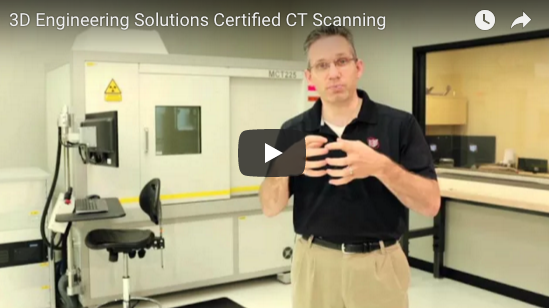3D Engineering Solutions Certified CT Scanning
I am here today to share how 3D Engineering Solutions is a leader in CT scanning engineering. I’ll explain how we are the only company to have a piece of CT equipment to our ISO 17025 scope. This new piece of equipment allows us to perform more accurate scans.
Watch the video to learn more about the unique services that only 3D Engineering Solutions can provide.
Video Transcript
Hello my name is Robert Glassburn and I’m with 3D Engineering Solutions. Today I want to talk about certified CT scanning. The first question to ask is, what does that mean? The answer to that is it is a way to ensure the accuracy of the dimensions that you’re getting out of the equipment.
The Traditional CT Scanning Method
Traditional CT scanning requires you to measure artifacts before or after the scan, or maybe both, in order to ensure the dimensional accuracy of the measurements you get. Again, traditional CT has not really been used for dimensional reasons predominantly.
The New 3D Engineering CT Scanning Method
With the advent of some new equipment like I’ll show you here, it’s allowed us to do a lot more with CT. As a service provider we provide dimensional services using many different technologies and CT scanning being the latest. Certified CT scanning is relatively new concept as I mentioned. The reason it’s needed for us is a lot of our customers are quality managers, and they want a way to ensure to their end customers that the dimensions that we give them are in fact accurate and can be traced back to a National Laboratory..
Our New ISO 17025 Equipment
We have in fact added this new piece of equipment to our ISO 17025 scope and so now, as our understanding is, we’re the only one to have a piece of CT equipment on a 17025 scope as of this date. The differences again are on the older style of CT machines, you would have to measure an artifact before or after the scan or maybe both, and then you’ll use that information and it’s known dimensions or links to scale to understand what the measurement the actual article that you want to measure is. This equipment you don’t have to do that. Simply place the parts that you’re interested in it into the machine, scan, bring those results into your processing software, and then you can take measurements directly. The ability of this machine to do that is based on some mechanical things and some things that they’ve done with the software and hardware combined.
The 3 Major Benefits
The three major things are:
- the temperature control chamber, that’s controlled within ± 1°C.
- The fixed source to detector distance, which is later calibrated.
- And then the linear scales that are used inside of it or linear scale that used to verify what the magnification is.
Traditional vs. 3D Engineering
So in a traditional machine for example, you have an encoder that moves the object on its table backwards or forward, closer or further away from the source and detector and then that number of clicks or movements from that encoder is fed into the equipment and that determine your magnification. What was missing from that is a feedback mechanism, to tell you exactly what you actually moved. So the stepper motor will go out so far and this machine has a feedback mechanism, a linear scale that says, “I told it to go out this far, how far to actually go? Do they agree? Make a correction for it.” So we know exactly what the magnification is. That’s a large factor in understanding dimensional accuracy. Again, we’re the first company that we’re aware of to offer that on a scope. Measurement uncertainties that we’re able to calculate for this are 11 + 30 X (X is in meters). This won’t accept a very large part per se, you won’t put a 2 meter part in there, but that’s just the way the scale is going. That’s a little higher than the accuracy that’s listed for this machine, but that’s normal for measurement uncertainty, because we’re adding other factors than what the manufacturer would normally include.




Leave a Reply
Want to join the discussion?Feel free to contribute!